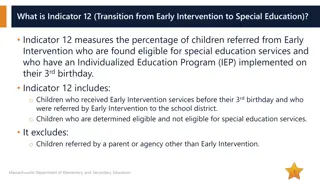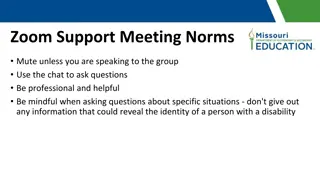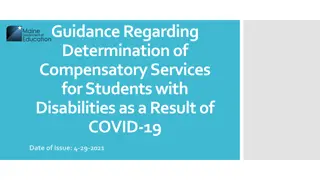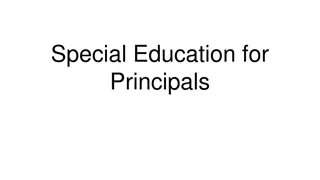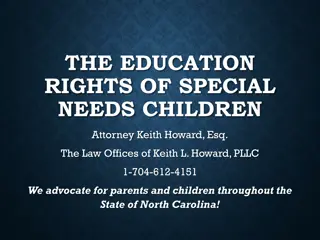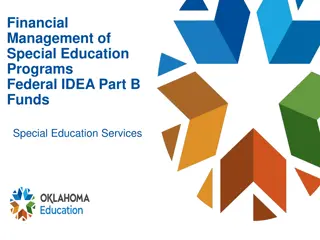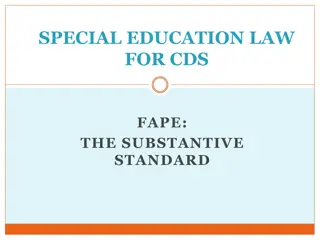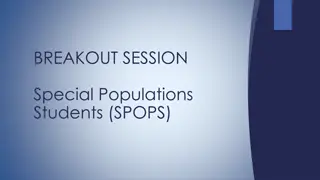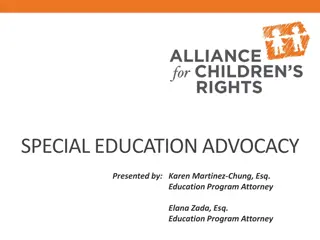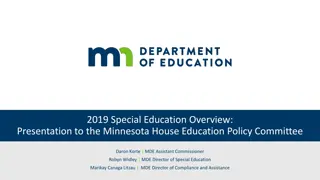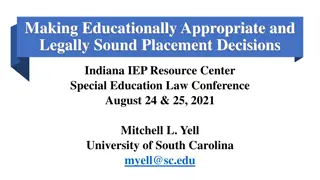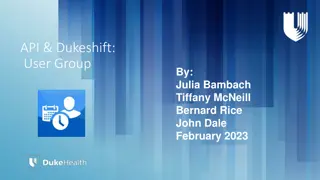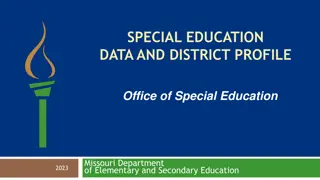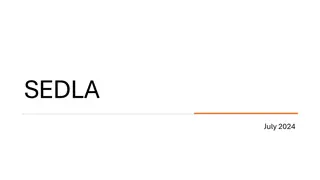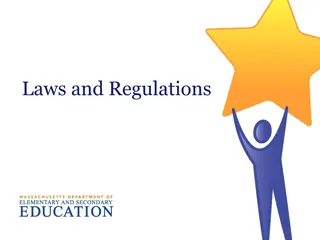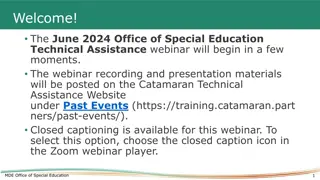Free Appropriate Public Education (FAPE) in Special Education
FAPE in special education ensures that eligible students with disabilities receive individualized programs at no cost, meeting state standards. The concept, originating from the Supreme Court decision in Rowley, emphasizes the provision of educational benefits through an Individualized Education Program (IEP) that is reasonably calculated to optimize student learning. The legal framework includes compliance with IDEA procedures and a two-part test to determine educational appropriateness. FAPE defines the state's obligation to provide a basic level of educational opportunity for students with disabilities.
Download Presentation

Please find below an Image/Link to download the presentation.
The content on the website is provided AS IS for your information and personal use only. It may not be sold, licensed, or shared on other websites without obtaining consent from the author.If you encounter any issues during the download, it is possible that the publisher has removed the file from their server.
You are allowed to download the files provided on this website for personal or commercial use, subject to the condition that they are used lawfully. All files are the property of their respective owners.
The content on the website is provided AS IS for your information and personal use only. It may not be sold, licensed, or shared on other websites without obtaining consent from the author.
E N D
Presentation Transcript
Free Appropriate Public Education WDE Technical Assistance Presentation January 2015
FAPE means special education and related services that: Are provided at public expense, under public supervision and direction, and without charge; Meet the standards of the SEA, including the requirements of this part; What is FAPE? 2 WDE TA Series January 2015
Include an appropriate preschool, elementary school, or secondary school education in the State involved; AND Are provided in conformity with an individualized education program (IEP) that meets the requirements of 300.320 through 300.324. 34 C.F.R. 300.17 What is FAPE? 3 WDE TA Series January 2015
The practical definition of FAPE originates from the landmark Supreme Court decision in Rowley. It has been tested many times, and it remains the standard today. In summary, FAPE is an IEP, developed consistent with the IDEA s procedural safeguards, that is reasonably calculated to enable the student to receive educational benefit. What is FAPE? 4 WDE TA Series January 2015
In Rowley, the Supreme Court established the following two-part test that courts should use to decide the appropriateness of a student's education. Courts must ask: 1. Has the state complied with the procedures set forth in the IDEA? 2. Is the IEP, developed through the IDEA's procedures, reasonably calculated to enable the child to receive educational benefits? What is FAPE? 5 WDE TA Series January 2015
The Supreme Court held that when this two-part test is satisfied, the state has complied with the obligation imposed by Congress, and the courts can require no more. Board of Educ. of the Hendrick Hudson Cent. Sch. Dist. v. Rowley, 553 IDELR 656 (U.S. 1982). What is FAPE? 6 WDE TA Series January 2015
In Rowley, the Supreme Court made it clear that the IDEA does not require districts to provide students with disabilities with the best possible education. Referring to the minimal level of benefits that an appropriate educational program must confer, the Supreme Court termed the state's obligation as being the provision of a "basic floor of opportunity." The Standard 7 WDE TA Series January 2015
Central to the IDEA is the requirement that local school districts develop, implement, and annually revise an IEP that is calculated to meet the eligible student's specific educational needs. Thompson R2-J Sch. Dist. v. Luke P., 50 IDELR 212 (10th Cir. 2008), cert. denied, 110 LRP 798 (2009). Thus, the determination of whether a FAPE has been provided turns in large part on the sufficiency of the IEP for each disabled child. Tyler V., ex rel. Desiree V.v.St.VrainValleySch.Dist.No.RE-1J, 56 IDELR 165 (D. Colo. 2011). The Standard 8 WDE TA Series January 2015
As the Tenth Circuit has noted, this standard is not onerous as "Congress did not impose upon the States any greater substantive educational standard than would be necessary to make ... access meaningful ... [t]he intent of the Act was more to open the door of public education to handicapped children on appropriate terms than to guarantee any particular level of education once inside. The Standard 9 WDE TA Series January 2015
Congress did not guarantee children "a potential- maximizing education." Rather, Congress sought only to require a "basic floor of opportunity" aimed at providing individualized services sufficient to provide every eligible child with "some educational benefit. Thompson R2-J Sch. Dist. v. Luke P., 50 IDELR 212 (10th Cir. 2008), quoting Bd. of Educ. of the Hendrick Hudson Cent. Sch. Dist. v. Rowley, 553 IDELR 656 (U.S. 1982). The Standard 10 WDE TA Series January 2015
FAPE must include special education. It is individually designed for every student annually. It is an IEP that is reasonably calculated to result in educational benefit. It is not intended to maximize success. It is delivered in the LRE. It is free. What does this mean? 11 WDE TA Series January 2015
Special education means specially designed instruction, at no cost to the parents, to meet the unique needs of a student. Specially designed instruction means adapting, as appropriate to the needs of an eligible child, the content, methodology, or delivery of instruction to Address the unique needs of the child that result from the disability; AND Ensure access of the child to the general curriculum. 34 C.F.R. 300.39. Special Education 12 WDE TA Series January 2015
Related services means transportation and such developmental, corrective, and other supportive services as are required to assist a child with a disability to benefit from special education. 34 C.F.R. 300.34. Related Services 13 WDE TA Series January 2015
General Curriculum Special Education supports the general curriculum Related Services wrap around and support special education The Relationship 14 WDE TA Series January 2015
A child who only needs a related services is not an eligible student under the IDEA. 34 C.F.R. 300.8(a)(2). The IDEA's definition of "related services" expressly contemplates that a child is receiving some type of special education. Jefferson County Sch. Dist. R1 v. Elizabeth E., 60 IDELR 91 (10th Cir. 2012). The Relationship 15 WDE TA Series January 2015
Each State must ensure that FAPE is available to any individual child with a disability who needs special education and related services, even though the child has not failed or been retained in a course or grade, and is advancing from grade to grade. The right to FAPE extends to students who have been suspended or expelled from school. 34 C.F.R. 300.101. Who is entitled to FAPE? 16 WDE TA Series January 2015
States that receive federal funding under the IDEA must provide all eligible students with a free appropriate public education ("FAPE"). "To provide an eligible student with a FAPE, states must develop an [Individualized Education Plan] for each qualifying student." Sytsema v. Acad. Sch. Dist. No. 20, 50 IDELR 213(10th Cir. 2008). Who is entitled to FAPE? 17 WDE TA Series January 2015
All IDEA eligible students have a right to receive FAPE through an IEP. FAPE is available to students who are academically on target, but whose education is adversely affected by disability socially, emotionally, communicatively, or functionally. Education includes more than academics. What does this mean? 18 WDE TA Series January 2015
Developing an IEP is a cooperative process. It is much more than simply completing forms. IEPs must align with state standards and the general curriculum. The purpose of the IEP is to improve outcomes for students with disabilities. FAPE & the IEP 19 WDE TA Series January 2015
Evaluatio n PLAAFP Goals Services Placement Progress 34 C.F.R. 300.301 through 300.306. The Evaluation 20 WDE TA Series January 2015
The purpose of the initial evaluation is to determine: If the child has an IDEA disability, AND The educational needs of the child. 34 C.F.R. 300.301(c)(2). Initial Evaluation 21 WDE TA Series January 2015
The purpose of the reevaluation is to determine: Whether the child continues to have an IDEA disability, AND The educational needs of the child. 34 C.F.R. 300.305(a)(2). Reevaluation 22 WDE TA Series January 2015
The evaluation must be sufficiently comprehensive to identify all of the child s special education and related service needs, whether or not commonly linked to the child s disability. 34 C.F.R. 300.304(c)(6). Assessment tools and strategies provide relevant information to assist in determining the educational needs of the child. 34 C.F.R. 300.304(c)(7). Evaluation Procedures 23 WDE TA Series January 2015
Evaluatio n PLAAFP Goals Services Placement Progress 34 C.F.R. 300.320(a)(1) The PLAAFP 24 WDE TA Series January 2015
Appropriate IEPs "must contain statements concerning a disabled child's level of functioning, set forth measurable annual achievement goals, describe the services to be provided, and establish objective criteria for evaluating the child's progress." Endrew F. v. Douglas County Sch. Dist. RE 1, 64 IDELR 38 (D. Colo. 2014), quoting J.P. v. County Sch. Bd. of Hanover County, 49 IDELR 150 (4th Cir. 2008). PLAAFP 25 WDE TA Series January 2015
A statement of the childs present levels of academic achievement and functional performance, including How the child s disability affects the child s involvement and progress in the general education curriculum (i.e. the same curriculum as for nondisabled children), or For preschool children, as appropriate, how the disability affects the child s participation in appropriate activities. 34 C.F.R. 300.320(a)(1). PLAAFP 26 WDE TA Series January 2015
The failure to conduct a comprehensive evaluation of the student s educational needs resulted in a finding that the IEP was inappropriate and the PLAAFP were invalid. Pinto v. District of Columbia, 64 IDELR 103 (D.D.C. 2014). PLAAFP 27 WDE TA Series January 2015
The IEP was found inadequate because goals were not based on PLAAFP. "An IEP begins by measuring the student's present level of performance -- affectionately known as [PLAAFP] -- which provides a benchmark for measuring the student's progress toward the goals stated in the IEP. Ravenswood City Sch. Dist. v. J.S., 59 IDELR 77 (N.D. Cal. 2012), quoting Settlegoode v. Portland Pub. Schs., 41 IDELR 9 (9th Cir. 2004). PLAAFP 28 WDE TA Series January 2015
PLAAFP describes educational needs. Several needs may be addressed by one goal. Needs may be prioritized with a scaffold of needed skills before moving on to the next need. It is not required to have a separate goal for each area or provider. 71 Federal Register 46662. PLAAFP Link to Goals 29 WDE TA Series January 2015
Evaluatio n PLAAFP Goals Services Placement Progress 34 C.F.R. 300.320(a)(2) Measurable Annual Goals 30 WDE TA Series January 2015
A statement of measurable annual goals, including academic and functional goals, designed to Meet the child s needs that result from the child s disability to enable the child to be involved in and make progress in the general education curriculum, and Meet each of the child s other educational needs that result from the child s disability. 34 C.F.R. 300.320(a)(2). Measurable Goals 31 WDE TA Series January 2015
The team must determine measurable annual goals based on student need that describe rigorous but reasonable targets that specify the skills to be gained by the student in one year. Measurable Goals 32 WDE TA Series January 2015
The lack of individualized planning denied a student FAPE. The use of vague language and stock goals was sufficient to uphold a determination that the school district denied the student FAPE. Jefferson County Bd. of Ed. V. Lolita S., 64 IDELR 34 (11th Cir. 2014). Measurable Goals 33 WDE TA Series January 2015
The IEP team need not draft IEP goals in a manner that the parents find optimal, as long as the goals are objectively measurable. Bridges v. Spartanburg County Sch. Dist. Two, 57 IDELR 128 (D.S.C. 2011). Measurable Goals 34 WDE TA Series January 2015
Goals are unique for each student. Goals must be measurable. Goals are intended to help the student be successful in the general curriculum, or a downward extension when needed. Goals can also address other needs that result from the student s disability. What does this mean? 35 WDE TA Series January 2015
Goals are intended to be written annually. Goals are intended to address skill deficits. It is the challenge of the IEP team to define goals in terms of a reasonable expectation of skill growth in one year. Remember, rigorous but reasonable! Goals are not lesson plans. 36 WDE TA Series January 2015
Evaluatio n PLAAFP Goals Services Placement Progress 34 C.F.R. 300.320(a)(4) IEP Services 37 WDE TA Series January 2015
The purpose of all IEP service is to help the student be successful in the least restrictive environment (LRE) as evidenced by progress toward meeting the annual goals. The team must determine what services the student needs in order to progress toward meeting the annual goals. IEP Services 38 WDE TA Series January 2015
Both the amount and type of services that a district is required to provide will depend on the child's identified needs. An IEP is not defective merely because it fails to include special education services requested by the parents if those services are not necessary for the child to receive FAPE. Winkelman v. Parma City Sch. Dist., 51 IDELR 92 (6th Cir. 2008), cert. denied, 109 LRP 38984 (2009). IEP Services 39 WDE TA Series January 2015
IEP services must be implemented as written! The failure to implement a material portion of the IEP amounts to a denial of FAPE. Sumter County Sch. Dist. 17 v. Heffernan, 56 IDELR 186 (4th Cir. 2011); A.P. v. Woodstock Bd. of Educ., 55 IDELR 61 (2nd Cir. 2010); Van Duyn v. Baker Sch. Dist. 5J, 47 IDELR 182 (9th Cir. 2007); Houston Indep. Sch. Dist. v. Bobby R., 31 IDELR 185 (5th Cir. 2000), cert. denied, 111 LRP 30885 , 531 U.S. 817 (2000); and Neosho R-V Sch. Dist. v. Clark, 38 IDELR 61 (8th Cir. 2003). IEP Implementation 40 WDE TA Series January 2015
Service providers must document IEP services. A public agency must keep accurate records of the services provided to special education students. The district s failure to produce tracking forms designed to account for all of the student s special education classes proved fatal to its claims, resulting in a compensatory education award. Sykes v. District of Columbia, 107 LRP 63730 (D.D.C. 2007). Service Provider Logs 41 WDE TA Series January 2015
OCR utilizes provider logs to confirm IEP implementation. When those logs are missing or incomplete, OCR will find a violation. School Administrative Unit #9, 111 LRP 16101 (OCR 2010). Service Provider Logs 42 WDE TA Series January 2015
Services must be provided consistent with the IEP. The public agency is required to keep documentation to verify compliance with IDEA. Service provider logs are an important piece of IEP documentation. Without provider logs, a public agency is vulnerable to a claim that it denied FAPE. What does this mean? 43 WDE TA Series January 2015
Evaluatio n PLAAFP Goals Services Placement Progress 34 C.F.R. 300.116 Placement 44 WDE TA Series January 2015
Placement decisions Must be made by a group of persons, including the parents and other persons knowledgeable about the child, interpretation of evaluation data, and placement options; AND Must be made in conformity with the LRE provisions of IDEA. 34 C.F.R. 300.116. Placement 45 WDE TA Series January 2015
To the maximum extent appropriate, children with disabilities are educated with children who are nondisabled. 34 C.F.R. 300.114(a)(2). To the maximum extent appropriate, children with disabilities are able to participate in extracurricular activities with children who are nondisabled. 34 C.F.R. 300.117. To the maximum extent appropriate, children with disabilities are provided supplementary aids and services to enable them to be educated with children who are nondisabled. 34 C.F.R. 300.42. The Three Maximums 46 WDE TA Series January 2015
The IDEA presumes that the first placement option considered for each child with a disability is the regular classroom in the school that the child would attend if not disabled, with appropriate supplementary aids and services to facilitate such placement. Therefore, before a child with a disability can be placed outside of the regular education environment, the full range of supplementary aids and services that could be provided to facilitate the child s placement in the regular classroom setting must be considered. 71 Federal Register 46588. LRE 47 WDE TA Series January 2015
Regular Classes Separate Classes Separate Schools Residential Settings Hospital or Homebound 48 WDE TA Series January 2015
Evaluatio n PLAAFP Goals Services Placement Progress 34 C.F.R. 300.320(a)(3) Progress 49 WDE TA Series January 2015
The IDEA requires every IEP include a description of: How the child's progress toward meeting the annual goals will be measured, and When periodic reports on the progress the child is making toward meeting the annual goals (such as through the use of quarterly or other periodic reports, concurrent with the issuance of report cards) will be provided. 34 C.F.R. 300.320(a)(3). Progress 50 WDE TA Series January 2015



